Malaysian Chicken Satay is Southeast Asia’s comfort food at its finest with a warm smoky flavor from healing ingredients such as galangal, spices, and citrusy lemons. The nutty satay sauce is peanut-speckled and cooked with an intensely aromatic spice paste. These juicy chicken satay sticks dipped in authentic homemade satay sauce will become your new favorite appetizer!
Sitting through my first fall in the Pacific Northwest, I cannot help but think of my husband’s childhood stories of when he visited his grandparents in Ipoh, Perak, in far-off tropical Malaysia. Believe me when I tell you that I love the cool bright colors of fall, watching the leaves turn from green to bright orange and finally to golden red. But there is something magical about the boundless warm blue-sky summers of the tropics. But more, one story stuck in my head, that of the satay man who was replete with a bicycle-mounted charcoal brazier who served up freshly made Malaysian Chicken Satay at the doorstep. It harkens me to simpler times in India when food was locally sourced, organically grown, and freshly prepared.
Origin:
While many argue that the Malaysian Chicken Satay originated on the island of Java, it is hard to argue that the origin of this meat on the stick delicacy can be traced back through Indian kebab to its Middle Eastern origins. Trade routes and merchants brought ideas as well as trade goods to Southeast Asia and in return brought back spices from these spice-laden islands. And true to any Southeast Asian cuisine, the kebab itself was transformed into something hyper-local. So when one asks for satay, be prepared that beyond the meat-on-a-stick grilled in charcoal origin, every town from Bali to Chiangmai will have its unique flavor profile based on the marinade sourced locally.
However, what makes the Ipoh satay truly unique is the peanut sauce and for that, you have to look at the history of Ipoh. Under British occupation, Perak became famous for two things: rubber and tin. While rubber plantations flourished, it was in the 1880s when tin was discovered in the Kinta Valley at the foothills of the Kledang Hills. But as the mining population grew, the miners also grew groundnuts as a cash crop. While the most famous of these small lot peanut farmers were centered around Menglembu (a suburb of Ipoh), Ipoh peanuts soon became famous as a snack food. Equally, they became the symbiotic dip for local Malaysian Chicken Satay.
While my husband spent his formative years in Singapore, which is equally famous for its historical ‘Satay Club’, to this day, he maintains that the satay that he enjoyed from that nameless satay man on his bicycle is by far the best he’s ever had. Perhaps it is a childhood memory and perhaps he has had better satays, but to him, every satay he has is savored and yet compared to this, the original.
I have tried various satay recipes over the years, but I believe that this Malaysian Chicken Satay recipe that I have created comes closest to recreating my husband’s childhood snack. To put it another way, this is his favorite satay recipe which is based on his family’s recipe. When it comes to friends and family, the split is even. Those who have a sweet tooth tend to favor the Indonesian sate, while those who prefer the savory tend to go for the Malaysian variety. But the key thing to remember is that it is the charcoal brazier that rounds the flavor. I’ve been in restaurants purporting to serve satay, where they pressure cook the meat and then fry it in oil before sticking it on skewers. I can see the attraction of doing this, but to be honest, it lacks the flavor of true barbeques. It is the marinade and charcoal that bring out the flavor.
The other element that is sometimes forgotten is the ketupat. In traditional Malaysian Chicken Satay, the ketupat is the essential carbohydrate. Satay meat and the peanut sauce are essentially all protein. To balance or soften that effect, steamed rice packed in young palm leaves is served as an accompaniment. Rice is packed in hexoid-shaped woven palm leaves and boiled. As the rice grains expand, they fill the pouch and pick up the subtle fragrance of the palm leaves. It is this method that gives the ketupat its form, texture, and flavor. I have found that satay without the accompanying ketupat is akin to having chicken curry noodles without the noodles.
As I’ve said earlier, this recipe is the closest I’ve come to recreating the Malaysian Chicken Satay or at least the Ipoh version of it. The most famous Malaysian Chicken Satay is the Kajang satay, which hails from a town in Selangor and is supposed to be richer and more flavorful, but here’s the rub: most families who make their satay subtly alter the ingredient proportions of the marinade, the length of the marination, and even the method in char-grilling the skewers. But to be candid, short of visiting Malaysia, if you want to have that sweet tropical burst of hot flavors in the cool fall and winter months, I assure you that this will hit the spot. I enjoy both the charcoal-grilled satay and the cast iron-grilled ones made at my home, and I hope you will too.
Frequently Asked Questions:
1. Could I use this recipe to make lamb satay?
Yes, this Malaysian Chicken Satay recipe works for lamb as well, although you will have to cook the lamb pieces for more time than the chicken on low heat. Some chefs prefer to pre-cook the lamb and then grill it.
2. Are there other methods of cooking the Malaysian Chicken Satay?
You could use an indoor grill, bake, air fry, or use a panini maker to cook the chicken satay. I find that this dish tastes great when made with a charcoal grill or a cast iron skillet.
Restaurants sometimes pre-cook the chicken and then grill them just before serving. The problem with this method is that the chicken is not very flavorful and sometimes they are undercooked. I usually request that the satay is well done before placing my order. It is best to cook the chicken completely on the grill as it tastes much better than restaurant versions. Once you try this tried and tested family recipe, you will not only love it but will keep it on rotation.
3. What is the difference between Indonesian and Malaysian Chicken Satay?
My husband’s own penchant for the Malaysian Chicken Satay stems from the fact that the marinade blend contains lemongrass and palm sugar. Generally, Malaysian Chicken Satay marinades do not contain the kecap manis flavored by the Indonesians and this gives the Malaysian satay a golden-brown sheen as opposed to the darker brown of Indonesia. Another fundamental difference is that Indonesians tend to use pepper, whereas the Malaysian version uses ground chilis.
If you’ve tried this recipe or have questions, I would love to hear from you. Please feel free to share (below) your thoughts, comments, or any questions that you might have. And if you like my recipes, you could subscribe to my mailing list for the latest recipes that will be delivered straight to your inbox. From my pen to your table, Bon Appetit!
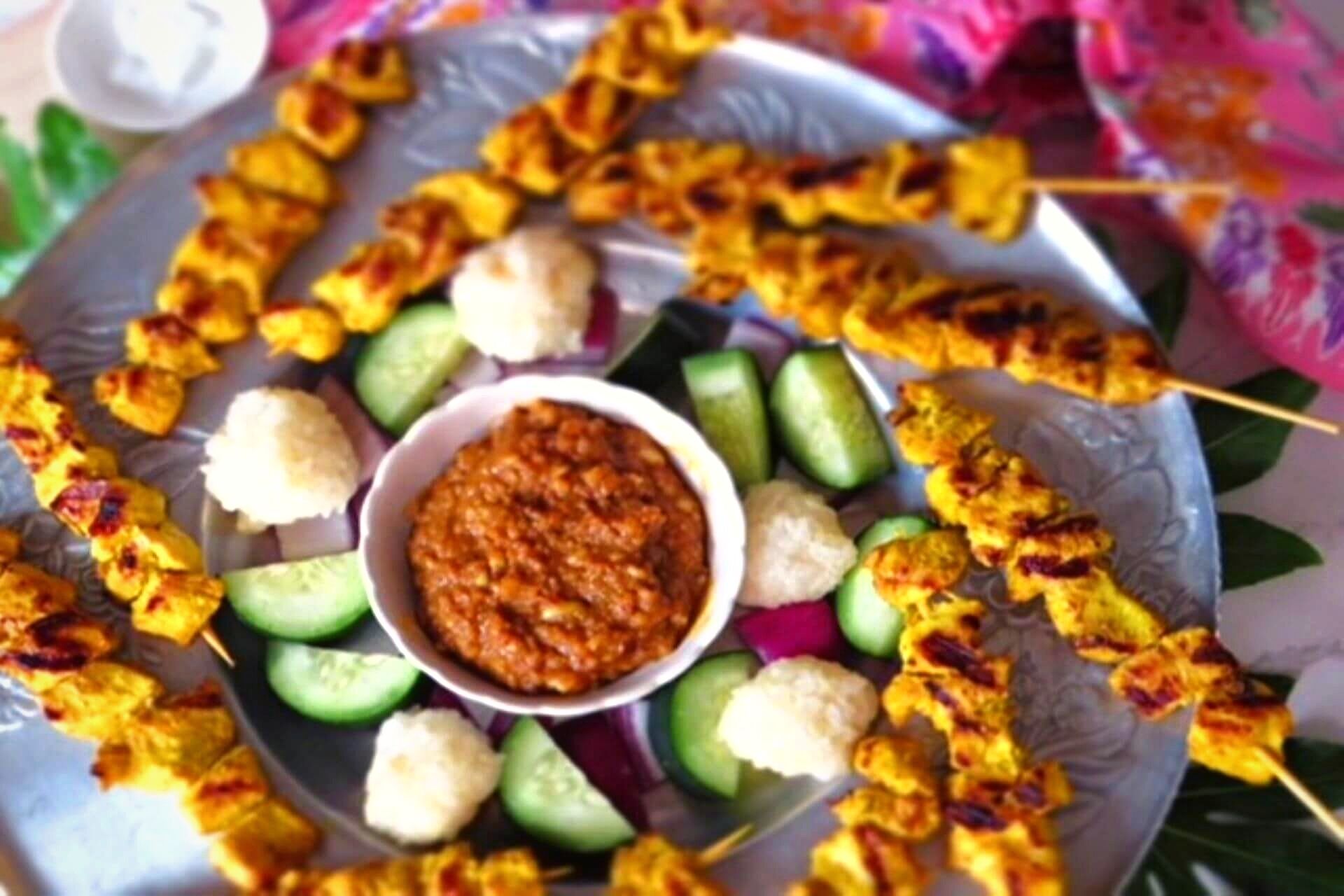
Ingredients:
For the marinade:
- Meat: boneless chicken breasts, skinned and fat trimmed; I have also used boneless leg of lamb
- Aromatics: shallot, galangal
- Spices: turmeric ground, coriander powder, ground cumin, chili powder, ground white pepper; curry powder is traditionally not an authentic substitution
- Sauce: light soy sauce; or you could use a mixture of vinegar and dark soy sauce
- Sweetener: honey and a pinch of coconut palm sugar
- Lemon: lemon or lime juice
- Oil: peanut oil is preferable; you could swap it for sesame or coconut oil
For the satay sauce:
- Aromatics: pearl onion, garlic, lemongrass, galangal
- Tamarind: wet seedless tamarind or the paste
- Spices: dried red chili, coriander powder
- Nuts: roasted peanuts
- Oil: coconut oil, peanut oil
- Sugar: coconut palm sugar
- Sauce: kecap manis
How to make the Malaysian Chicken Satay:
- How to marinate and grill the chicken skewers:
- Prepare the ingredients. Chop the chicken breasts into 1/2″ thick cubes.
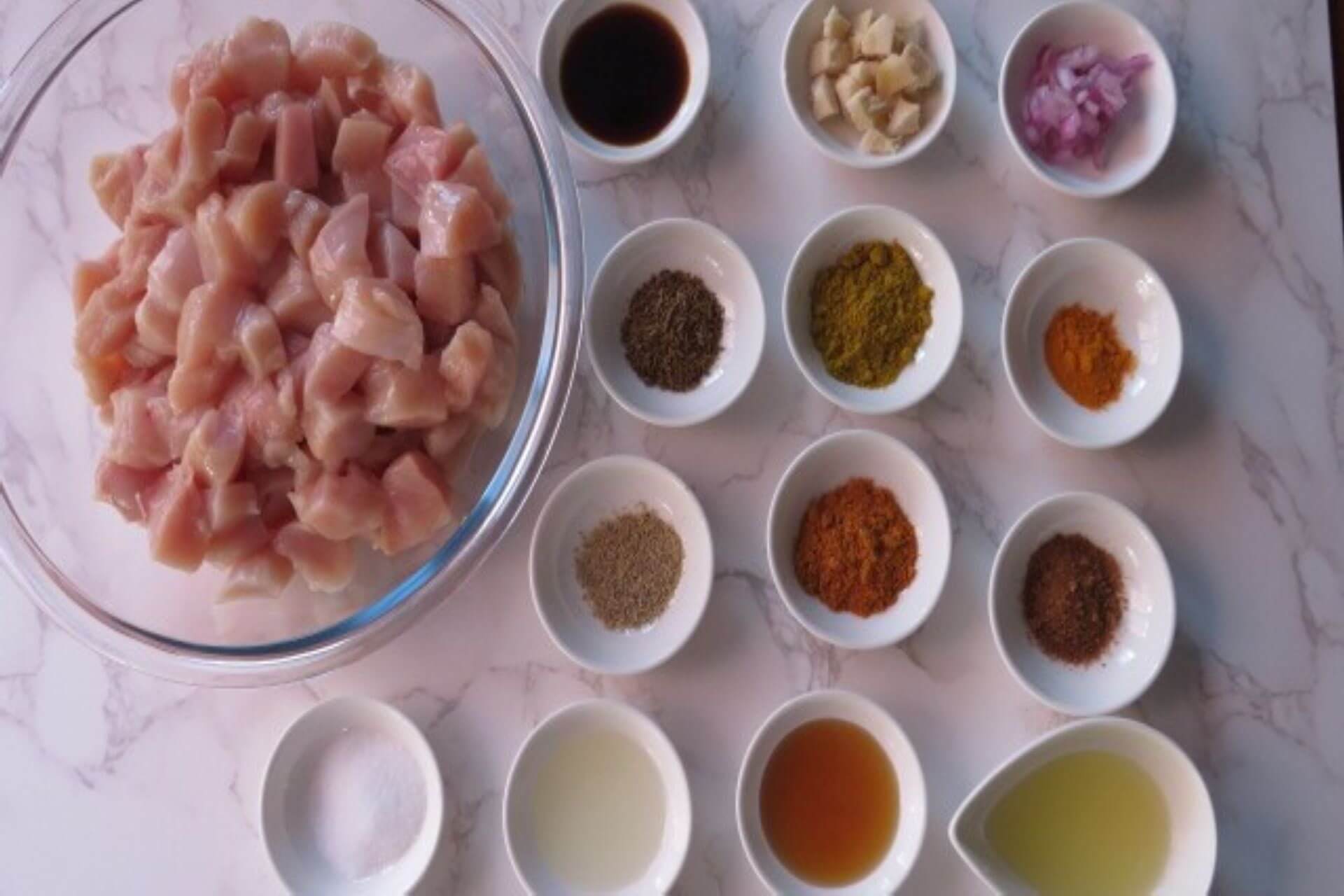
- Place the ingredients for the marinade in a food processor.
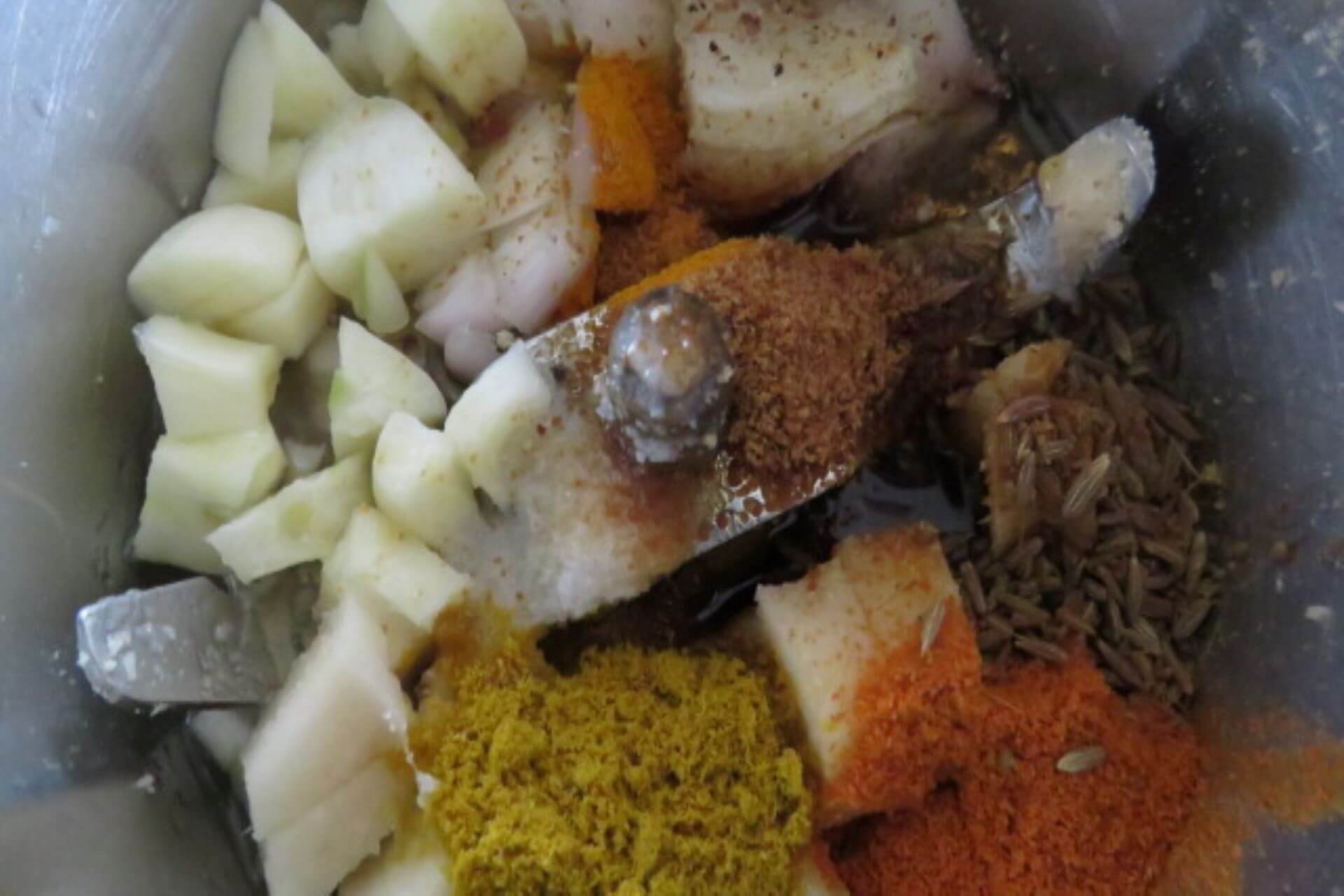
- Grind to a smooth paste using a teaspoon of water as needed.
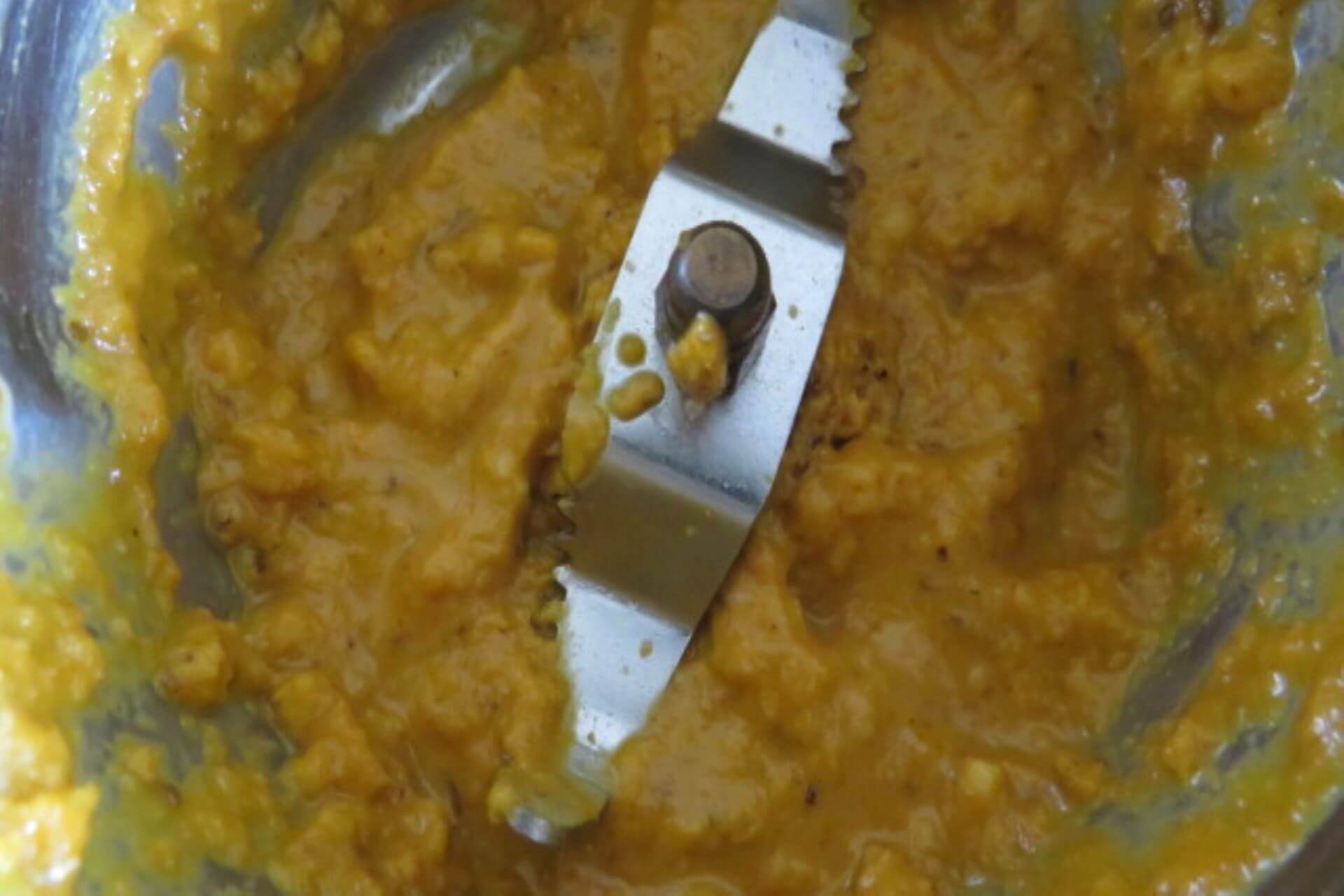
- Rinse and drain the chicken thoroughly. Rub the marinade into the chicken, covering every piece of chicken with the marinade. Refrigerate in a bowl covered with a lid for a few hours or preferably overnight.
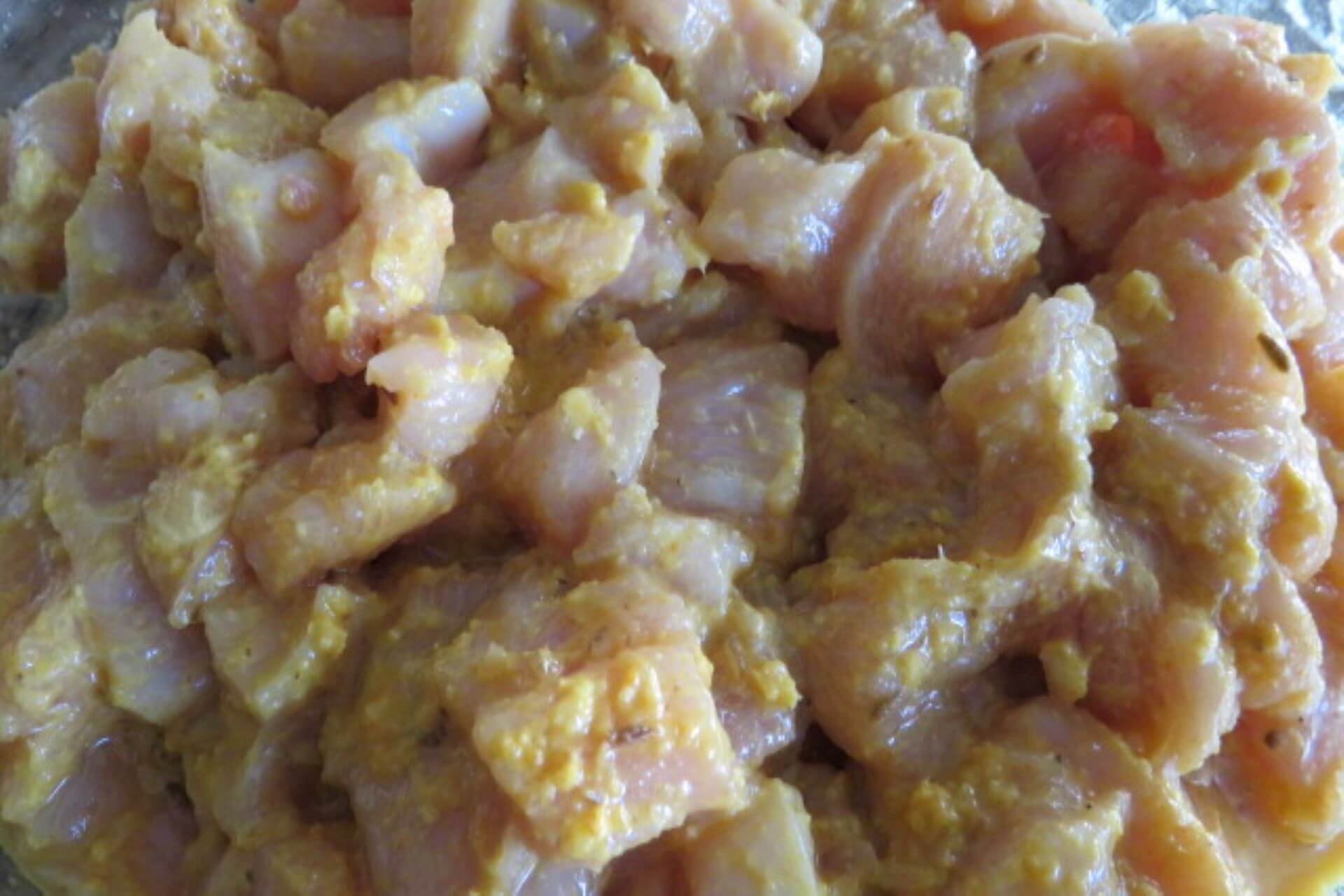
- Soak the wooden skewers for 10-15 minutes in a flat-bottomed bowl of water. Take one skewer at a time, and thread a few pieces of chicken.
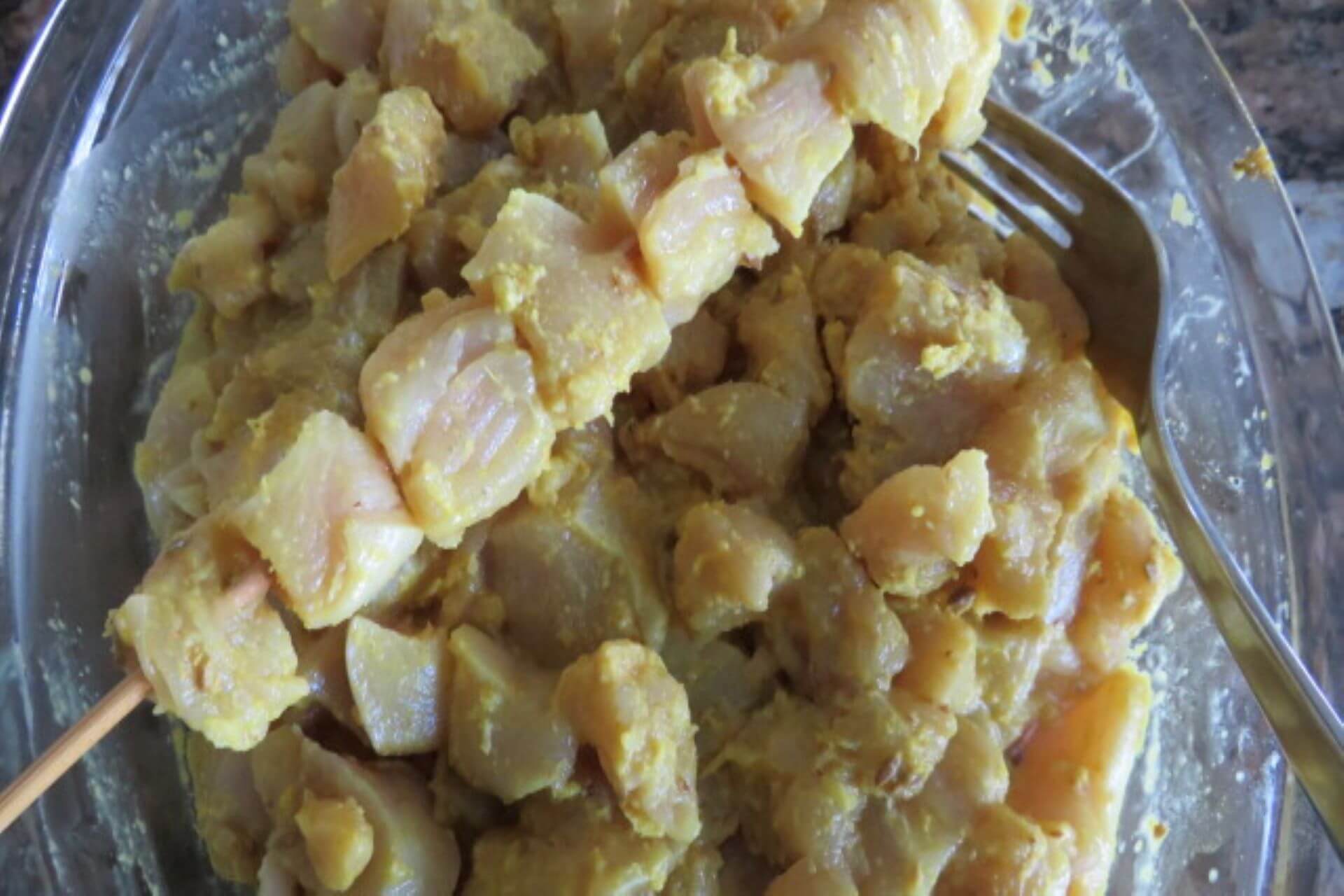
- Once you have threaded together all the chicken pieces on the skewers, heat a cast iron skillet. Brush the satay sticks with peanut oil and place three skewers diagonally on the skillet. Cook for 10-12 minutes on low-medium heat on one side.
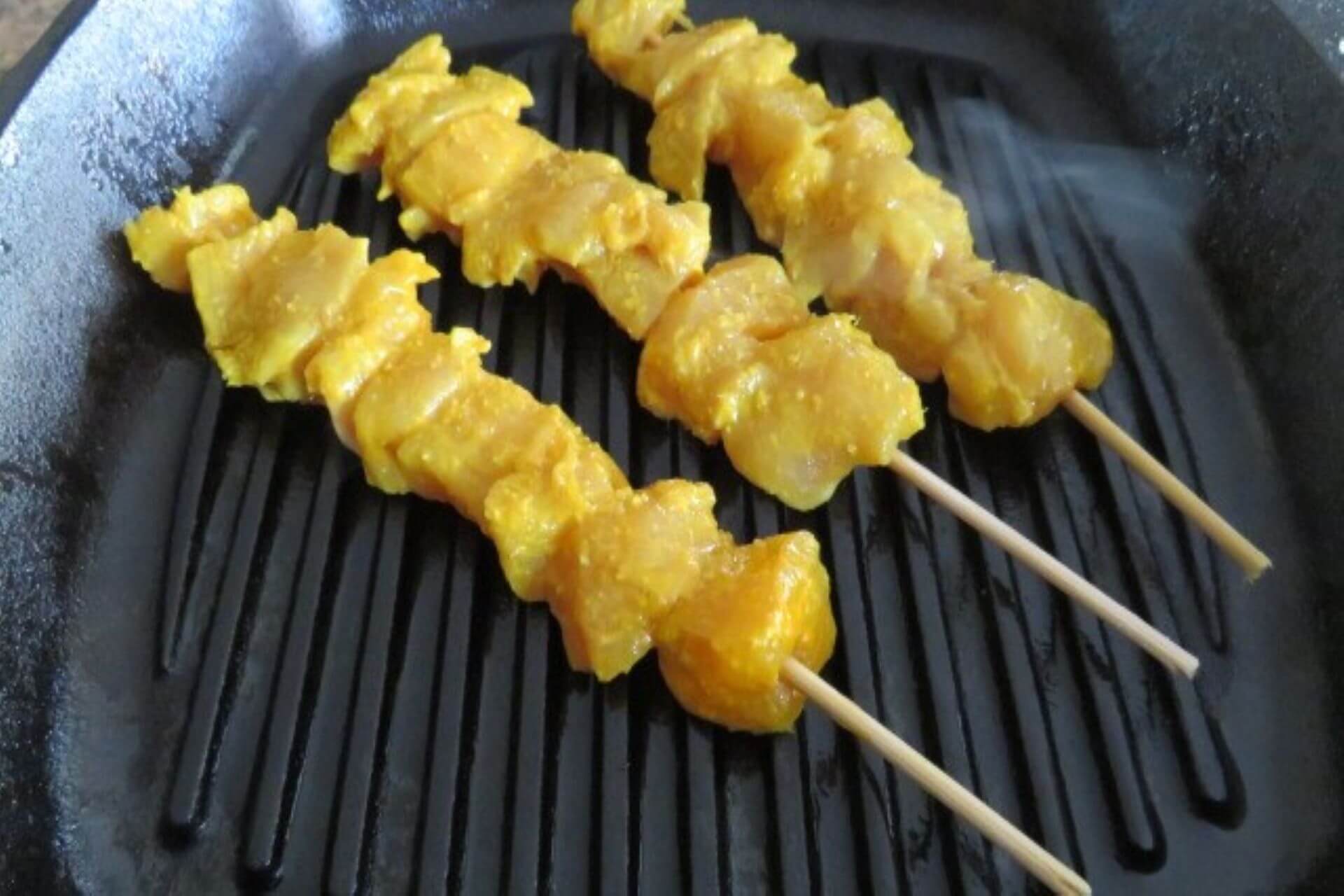
- Flip the skewers over and cook for another 10-12 minutes on low to medium heat. Give some room between skewers, allowing the chicken skewers to cook on all sides. Remove the skewers from the skillet and keep aside.

2. How to make the satay sauce:
- Prepare the ingredients for the satay sauce. Soak and grind the shallot, red chili, galangal, lemongrass and garlic with a tablespoon of water. Soak the wet tamarind in ⅓ cup of water for 10 minutes and strain the pulp.
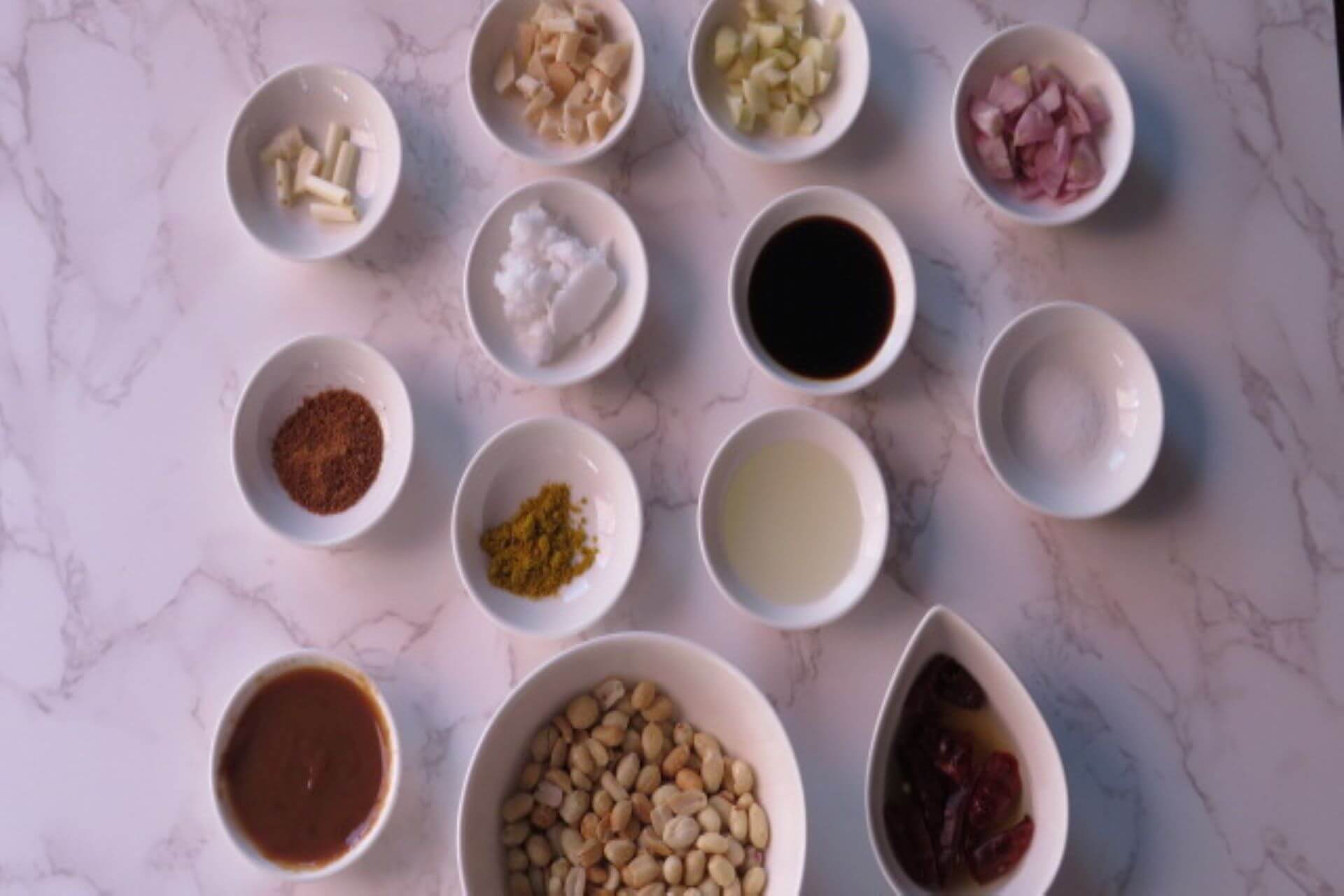
- Heat a small saucepot, add the peanut oil and aromatics mixture and cook for about 4 minutes.
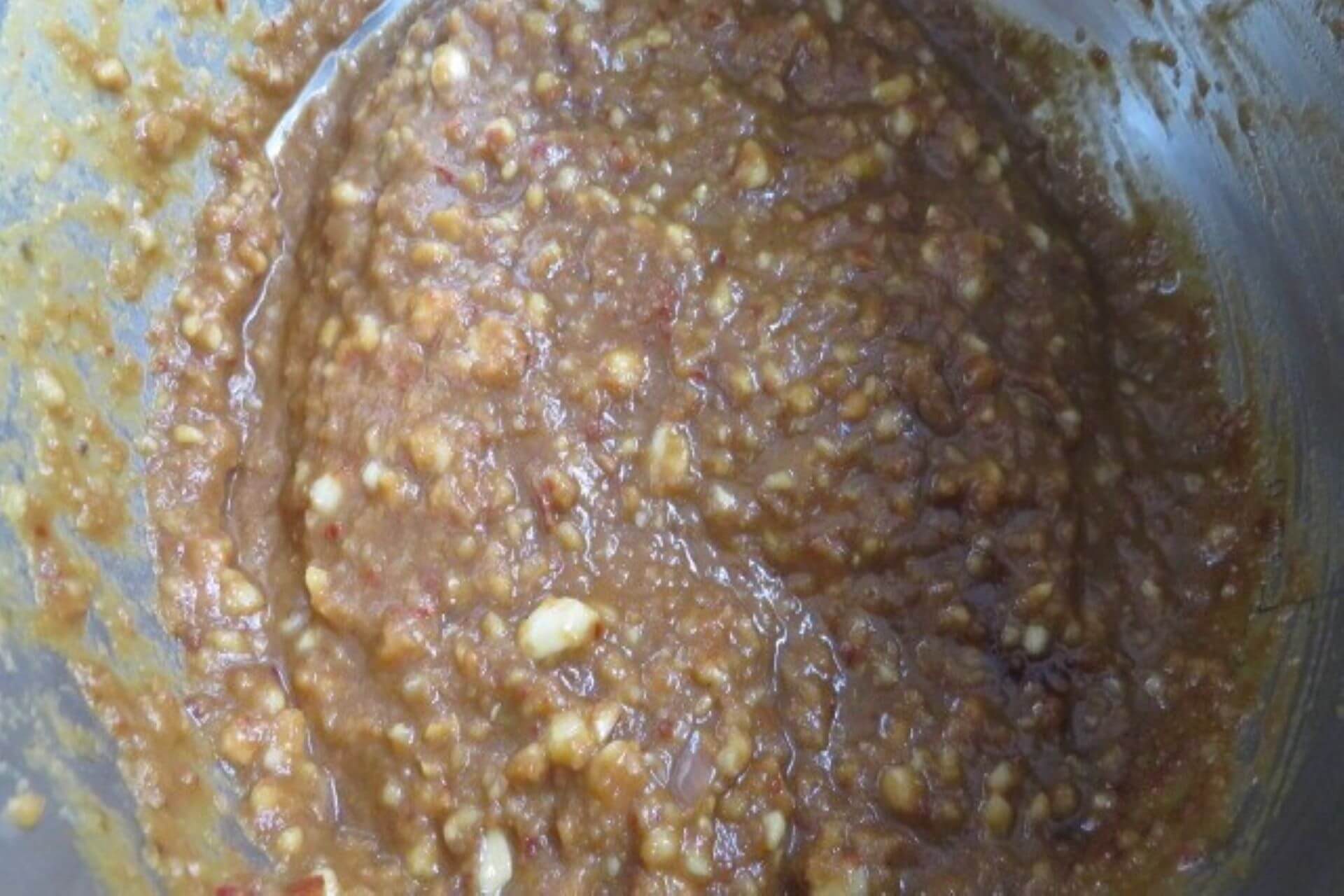
- Stir in the coconut oil and optionally, a tablespoon of peanut butter. Cool and serve the satay sauce with the chicken satay sticks.
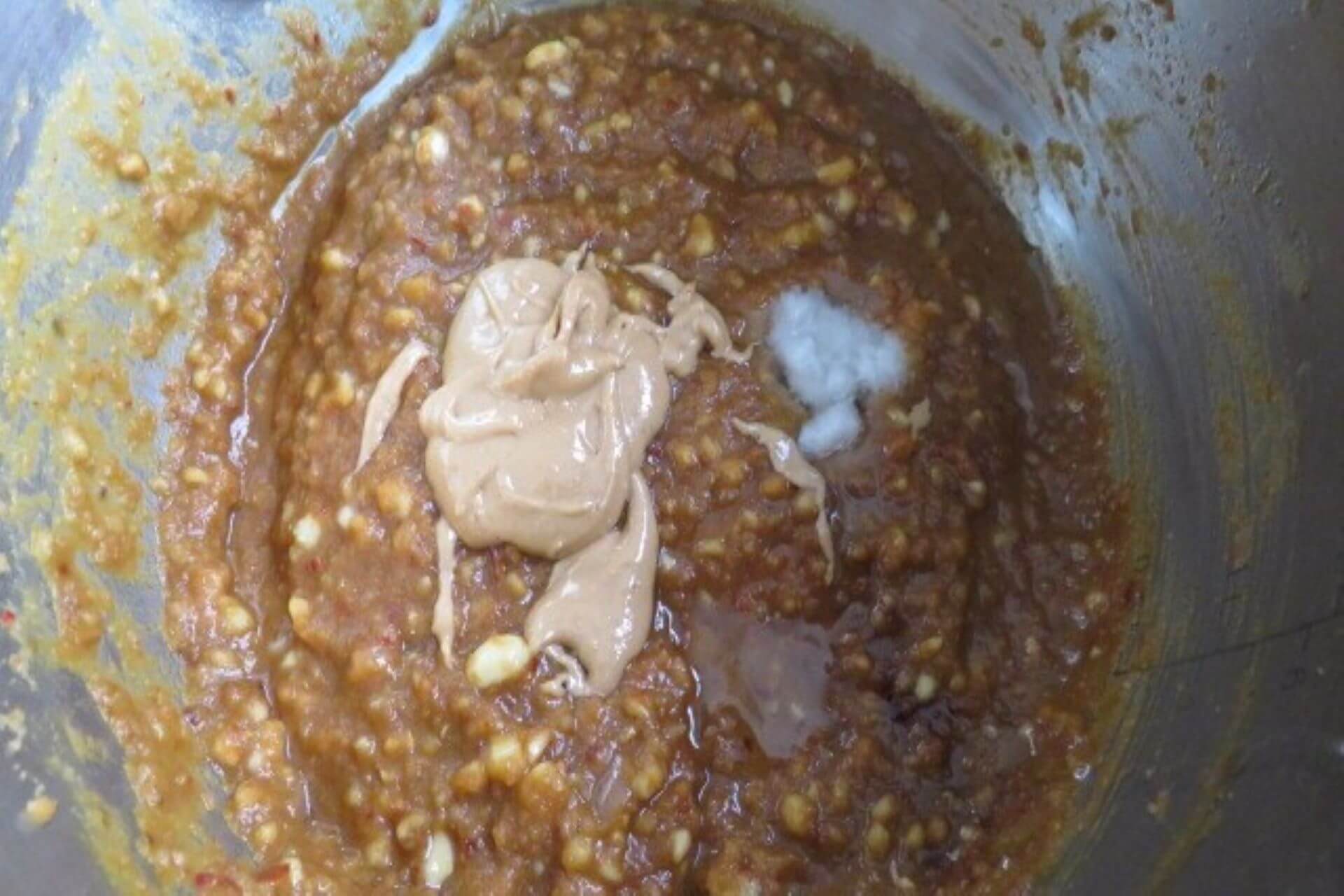
- Cool and serve the satay sauce with the chicken satay sticks.

Tips:
- Flip over the chicken skewers now and then to prevent burned parts or bits. Burned chicken is unhealthy, so brush it with oil before grilling. A lightly charred chicken satay is what you should be going for.
- Cut the chicken into even-sized pieces to help with proper cooking. The cooking time will depend on the size of the pieces.
Serving suggestions:
This Malaysian Chicken Satay is served with rice ketupat (see blog post above), cucumber slices and satay sauce as an appetizer. It also pairs well with Nasi Kuning.
Storage:
Malaysian Chicken Satay can be refrigerated in boxes for three days and frozen for three months. I have frozen the marinated chicken for a few days and then thawed the meat to room temperature before grilling for parties.
Other chicken recipes that you would like to try:
Malaysian Chicken Satay
Equipment
- cast iron griddle, mixing bowl
Ingredients
For the marinade:
- 2 lb chicken breast (boneless)
- 3 Asian shallot
- 1 tbsp galangal chopped
- 1½ tsp coriander powder
- 1¼ tsp turmeric powder
- 1¼ tsp ground cumin
- 1¼ tsp salt
- 2 tsp light soy sauce low sodium
- 2 tsp honey
- ½ tsp white peppercorn cracked
- 1 tsp chili powder
- ½ tsp coconut palm sugar
- 2 tbsp peanut oil (+2 tbsp for brushing)
- 1 tbsp lemon juice
For the satay sauce:
- 1 shallot
- 1 tbsp garlic chopped
- 4 dried red chili deseeded, soaked
- 1 tbsp galangal chopped
- 1 lemongrass white part
- ½ tsp coriander powder
- 1½ tbsp tamarind pulp
- 1 tbsp kecap manis
- ¾ cup roasted peanuts skin removed
- 1 tsp salt
Instructions
How to marinate the chicken for the satay:
- Prepare the ingredients. Chop the chicken breasts into 1/2" thick cubes.
- Place the ingredients for the marinade in a food processor.
- Grind to a smooth paste and keep aside.
- Rinse and drain the chicken thoroughly. Rub the marinade into the chicken, making sure to cover every piece of chicken with the marinade. Refrigerate in a bowl covered with a lid for a few hours or preferably overnight.
How to grill the satay:
- Soak the wooden skewers for 10-15 minutes in a flat bottomed bowl of water. Take one skewer at a time, thread a few pieces of chicken.
- Once you have thread together all the chicken pieces on the skewers, heat a cast iron skillet. Brush the satay sticks with peanut oil and place three skewers diagonally on the skillet. Cook for 10-12 minutes on low-medium heat on each side.
- Flip the skewers over and cook for another 10-12 minutes on low to medium heat. Give some room between skewers, allowing the chicken skewers to cook on all sides.
How to make the satay sauce:
- Prepare the ingredients for the satay sauce. Soak and grind the shallot, red chili, galangal, lemongrass and garlic with a tablespoon of water. Soak the wet tamarind in ⅓ cup of water for 10 minutes and strain the pulp.
- Heat a small saucepot, add the peanut oil and aromatics mixture and cook for about 4 minutes.
- Now add the nuts, tamarind pulp and palm sugar. Cook by stirring it occasionally for 10 minutes on low to medium heat.
- Stir in the coconut oil and optionally, a tablespoon of peanut butter and turn off the heat.
- Cool and serve the satay sauce with the chicken satay sticks.
Video
Notes
- If you are using an indoor grill, then preheat to 320 degrees F and cook for 30-40 minutes by flipping over two or three times.
Nutrition


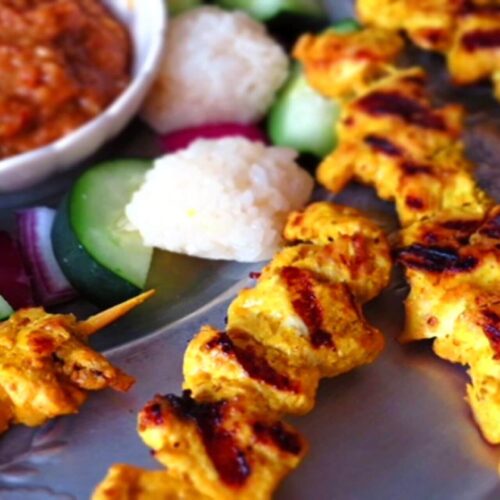
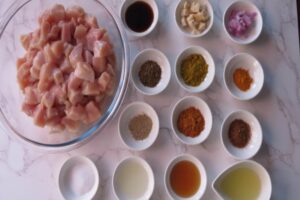
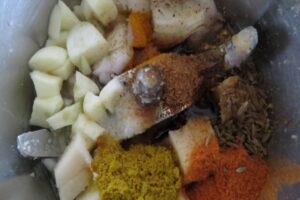
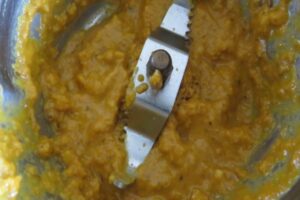
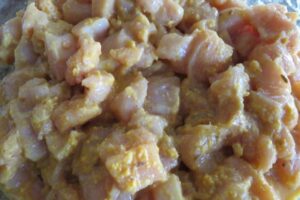
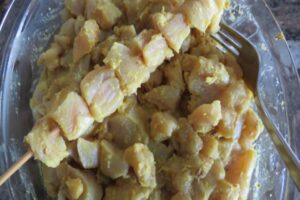


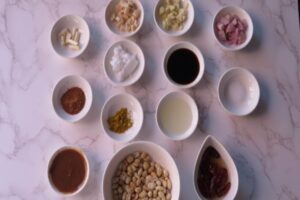
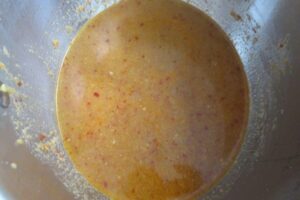
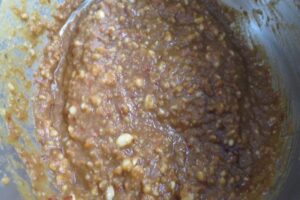
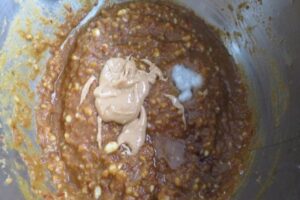






















0 Comments